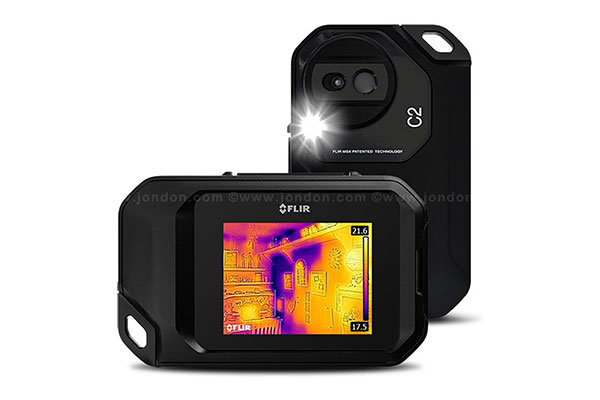Today, restoration professionals can make use of an infrared camera for water damage detection. Half of all restoration companies use thermal imaging for water damage restoration jobs. They are an awesome tool for discovering areas of interest. The thermal imaging camera is basically a tool that can be used to detect slight temperature differentials inside a home or business during or after a water loss. The infrared camera creates a visual image that allows the technician, as well as the home or business owner, to see areas that are possibly affected by water. Possible, because temperature differential images will only show areas that have different temperatures and that should then be inspected by using moisture meters.
The camera’s primary use is in quickly determining areas of interest. It used to be that a technician had to use a little guesswork to determine possible areas of concern. By using a thermal imaging camera a lot of the guesswork can be eliminated and signs of moisture or leaks can quickly be found.
How Do Infrared Cameras Work?
There is a lot of confusion as to what thermal imaging cameras can do. First of all, IR cameras are not able to “see” through walls, which is a good thing. Otherwise you wouldn’t be able to tell whether or not you were looking at an interior wall, an exterior one, or your neighbor’s wall. IR cameras “see” the same surface you are looking at. They detect infrared radiation reflecting off of or emitted by a surface. The camera then uses color to distinguish the different levels of that radiation. They can’t “see” wet, only temperature change!
As evaporation occurs cooling takes place (a human body sweats in hot temperatures because sweat cools the body as it evaporates). These sensitive infrared cameras can detect cooler temperature surfaces. They do not, however, directly detect or indicate the presence of moisture. They are only useful in detecting a temperature differential. They are usually so sensitive to temperature differences that they can detect as little as one degree of temperature difference across a surface.
A problem with the use of thermal cameras can occur if things have been wet for an extended period of time. As time passes, temperatures tend to equalize. In that case, the camera may not be able to sense any temperature differential between wet or dry materials.
Using Thermal Imaging Cameras In Restoration
When water damage is discovered the first thing to be done is water extraction. Once that is accomplished, technicians need a quick way to see where any further damage may be located. Investigating with an IR camera can find any of the following problems quickly: moisture, missing insulation, or air leakage. Since the camera cannot distinguish between the three, moisture detection meters are brought into play to further investigate areas of interest that the camera has detected.
Once drying has begun, the IR camera can be used to demonstrate drying progress. As may be indicated by the camera, other drying equipment can then be adjusted for areas that require additional attention. Since the evidence is visual, in picture format, customers can be shown that progress is being made at a satisfactory rate or has been completed.
Consumer confidence in your abilities is important to any restoration business. In water damage situations, people always talk to friends and relatives who are restorative drying “experts” without having any actual experience in the field. These individuals will raise questions and doubts about whether the job is being done correctly. Thermal imaging will provide you with additional credibility and can prove that you know what you are doing and that everything is under control and drying as planned.
Important IR Camera Features
There are several differences between different models of thermal imaging cameras. Below are some important features to look for when you decide to add an IR camera to your inventory:
- Display size
- Ways to save images
- Sensitivity to temperature differences (noise equivalent temperature differential ratings, NETD, the lower the number the better)
- Number of color palettes – gradients of color capable of being displayed
- Ease of use
- Voice recording
To remain competitive in water damage restoration, a company will need to seriously consider the addition of thermal imaging camera technology. Thermal imaging for moisture detection is not a replacement for using moisture meters. Moisture reading must be taken to verify what has been found by the camera. However, having a thermal camera will display to customers an entirely new level of professionalism.
When you choose Water Mold Fire Restoration to remediate water damage of any kind in your home, you have chosen one of the most competent companies in the water restoration industry. WMF technicians are equipped with the latest detection devices and are trained and certified to address any water damage issue. Response time is one hour or less from the time your call for assistance has been received. Our goal is to return your life and your home to normal as quickly as possible. Contact us by phone at 800-905-0277 or by email at help@watermoldfire.net.








